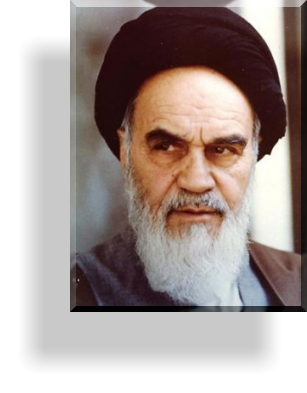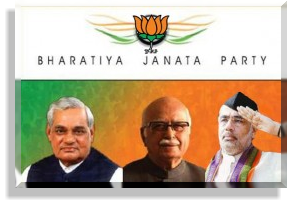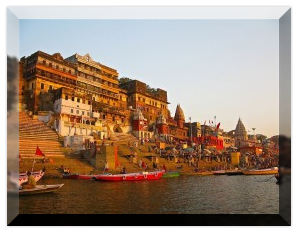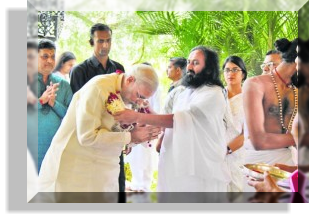





‘Knowledge is power’

Like the Iranian Islamic Revolution the Indian Elections 2014
Win by the BJP Was a Hindu Revolution:
the Why, the Need & the Effect
MIDDLE EAST
World’s
encyclopedic
knowledge
compacted
in
your
hand



The Three Part Series on the Hindu Revolution
(BJP/Modi won the Indian elections in 2014. Although the global philosophers haven't said so, in
a 3-part series this author argues that the change is a Hindu Revolution. This first part argues
why it is a Hindu Revolution (HR). Strengthening the case, the second part argues, why the
Hindus felt that a Hindu Revolution was necessary. The yet to be published third part will argue,
whether the world needs to fear the revolution like the Iranian Islamic Revolution.)
The Islamic Revolution in Iran
In 1970, surprisingly using a French government chartered flight, Ayatollah
Khomeini landed in Tehran amidst a thunderous applause that heralded an Islamic
Revolution in Iran. Not having the social media sites like the YouTube and Facebook,
or the concept of viral spread, TVs alone circulated the recorded videos worldwide.
However, after that moment, the only news that came out from the Islamic Republic
of Iran was that of killings, killings and more killings. Although atheistic revolutions
haven't killed any less, Religious revolutions have thus been frowned upon.
Indian Elections 2014: Just a BJP/Modi Victory
It is true that BJP/Modi got a clear majority in the elections 2014.
However, not having a known tyrant like the Shah of Iran, India seemed not to have
a reason for revolution. Instead, with it being one of the cycles of elections after
independence, a fight against a corrupt
and inefficient government that lacked a
strong leader, and a victory of a hard working
orator who made people believe in his Gujarat achievements and plans for future, it didn't seem to have even the R of the claimed
Hindu Revolution (HR). If not of Modi, it was a victory of the BJP. In fact, for the general population it was a new ray of hope: for
the Indian intellectuals it was a great incident to exchange ideas; for the Congress it was just a depressing cycle of cycles; for the
Mumbai stock market it was the best thing that ever happened in finance; and for the West it was the rise of a fearful divider, who
had to be loved. Still no sign of a revolution! Being a repeat, even the landslide victory wasn't historic.
Still no R of Religion
But then, with it ending coalition politics, initiating aggressive social media and 3D
technology use, transcending the traditional caste, creed and ethnic barriers to unite
voters in one platform of development, toppling a 'ruling dynasty' and proving pollsters
rights after two earlier mishaps, this election in 2014 has been a revolution in many ways.
Then again, far from the religious chants and violence in the Iranian revolution, it still
does not seem to have the R of religion here, let alone the H of HR.
What was Hindu in that Revolution?
If the fine print is assessed as by a lawyer, context as by a historian, behind the scenes as
by a director and ways as by a
psychologist, both the modus operandi and the reasons why it was indeed a HR will be clear.
For a start, as stated by a Chinese Ambassador, "India ruled China for 2000 years without sending a single soldier" and by the
global spread of Yoga and Meditation, unlike an Islamic revolution, HR is essentially feminine and silent. No wonder it necessitates
an expression like this.
It's true that the promised corruption free progress in economy and technology sounds secular/modern when seen through the
'traditional/conservatives' label, but it isn't haram for the Hindus. It is, in fact, not only halal but a feature to be aspired for in
Hinduism. And if historical nostalgia is brought in like the Abbasid period in Islam, it then becomes a goal that needs to be re-
achieved.
Using democracy that is best suited for power transfer to the non-consanguineous and non-ordained person, it peacefully
achieved a HR by using the prevalent cyclical elections. The brilliance was such that it was achieved without the hostile media even
raising an eyebrow.
This majority rule by an openly Hindutva vouching group is indeed historic, as it not achieved during the Hindu and Muslim
designated partition at independence, when the enigmatic Gandhi denied traditional Hindu Sardar Patel a legitimate prime-
ministership in favour of a westernised agnostic Nehru, and during the BJP's 1st rule when it had coalition constraints. And if
Indian history is extended further, the realisation that the Hindus are having their own rule and say for the first time in a
millennium or so will clearly air a major change in the Indian history. This in itself strengthens the case for a Hindu Revolution.
Hindutva (Hinduness) Everywhere: The Sangh Parivar
Furthermore, Hindutva is seen everywhere.
Although not quite the feared organisation that media portrays it to be, or a BJP
propelling organisation alone, the voluntary, patriotic and service oriented organisation
called Rashtriya Swayamsevak Sangh (RSS) is an institution that teaches discipline and
sacrifice. Unlike the media portrayal back home, RSS is praised outside India for its
voluntary work. As if A. L. Basham was on its side, it seeks to re-achieve the glory of India
that it once was, a utopian vision, before it went under the foreigners. That re-
achievement is going to happen through Hindutva (Hinduness). Its membership can
consist of ordinary members, but the dedicated ones, called pracharaks, have vowed to
sacrifice their lives and families for the sake of this vision. BJP itself is not just another party fighting
against corruption, or even like the Christian Democratic Union of Germany; as a political wing of the RSS, it has a distinct mission
related to Raj Dharma (ruler's duty). Along with other organisations it forms, what is called the Sangh Parivar (Family of
organisations).
The BJP Leader Mr Modi and His Hindutva
Although all its leaders aren't members of the RSS, much less dedicated members, some leaders of the party are members. Its
leader Modi, now a PM and a follower of the national icon Swami Vivekananda, is himself a pracharak. Almost reminiscent of Lord
Buddha, he has sacrificed his family life to achieve the ideals of the RSS. While his place
of birth explains the location of his pet project – the proposed Sardar Patel monument -
in Gujarat, and the resentment of injustice met by the Hindu tradition loving
Congressman during independence, explains the transcending of party affiliation - the
monument's magnitude (as the tallest statue in the world) alludes to the glory that BJP
aspires to recreate through Hindutva.
Hindu Revolution: The Showing and The Biting Teeth Tactic
Almost assuring Indians that the achievement will be under him, Mr Modi, who had
both Hindu strongman and developer credentials, was carefully selected by the Sangh
Parivar as their candidate for the PM.
Equally carefully, plans were made not to give any fodder to the grossly anti-Hindu media; rather to unify Hindus through both
development and Hindutva. This was done because, seeing the need for Hindu unity, both for a united voice and a victory, the
Sangh Pariwar that had used Ram temple issue before and succeeded, now saw it as a tired horse. It also saw the anti-Hindu
media alive and kicking. It, therefore, almost made the H word approach the N word in the USA. As carefully as choosing its leader,
and as if taking a cue from the 'divide and rule' of its previous masters, it brilliantly used the concept of 'biting and showing teeth'
to beguile the media. Lauding progress and development at every opportunity, and rendering its other intentions imperceptible, it
brilliantly split its ways into imperceptible Hindutva of the BJP and the perceptible yet un-discussed Hindutva of the RSS. With the
brilliance matching Osama bin Laden's capture, media traced Pak army's daze. As if to reassure the worried West, it even brought
in Muslim votes.
Hindu Revolution: The Showing Teeth
Although, BJP avoided even the H of Hinduism and amplified the development plans as said above, discerning eyes can see
Hindutva at work all the way.
To begin with, unlike a moderate Bajpai or a Jinnah praising Advani, the candidacy of
a hardliner Hindu, Modi, gives way to the importance of Hindutva in the things to
come. Although media reduced his brilliantly put 'I am a born Hindu and a nationalist
...' to a bland 'I am a Hindu nationalist', Hindutva was evident and media's inference
wasn't wrong. His hardliner image even brought in 'Pak enticed conspirators against
Modi, go to Pakistan', from a BJP member. As seen in his meetings with the gurus and
his mother, his greetings are unashamedly Hindu. While tracing history, and it not
being of Hindu tradition, he refused to darn an Islamic cap but not a turban, tracing
Hindu culture in his own terms and, in line with representing all citizens, he touched
the feet of an elderly Muslim. Constrained, he managed only a NO to the Pink
revolution.
Hindutva in the BJP Party Manifesto
The party itself wasn't entirely silent on Hindutva either. With the Ram temple issue depicting a wounded pride, absence of
Universal Civil Code mirroring inequality and Kashmiri Pundit refugees in their own homeland airing voicelessness of today's
Hindus, and Article 370 not being allowed by Raj Dharma, the goal to rectify them is not just a change from the status quo but a
revolutionary fulfilment of emotions that effects both the practice and thought of whole of India and beyond. Being an outcome of
a struggle by the religious rather than the secular, its plan to clean Ganga is very much religious. Although, the media satisfied
itself with those Hindutva agendas being put in the last pages of the BJP manifesto, the fact is that they are not there just for a
show.
Hindutva at the Religious Capital Benares
In addition, Benares, called Kashi by the devout, isn't just a cultural centre of India, as claimed. Having the lone Hindu university,
and bringing in global Hindus from all over the world for the pilgrimage at its famed Viswanath temple, for learning liturgy and
Vedic knowledge, and for performing the pre and post death rights including a holy dip, cremation and shraddha, almost like the
Vatican and Mecca, this oldest city in the world affiliated with the Hindu Lord Shiva is the religious capital of India. The attached
Ganges, twice mentioned in the Vedas, isn't like other rivers, and isn't even a symbolic mother alone. This Mother Ganga is a
remover of sin, whose holy water is taken globally like the Zamzam water in Islam. Next



1 2
BJP stalwarts Bajpai, Advani & Modi


Mother Ganga in Benares
Mr Modi wearing a traditional
Hindu Tika in his forehead

Mr Modi meeting Art Of
Lving guru Ravishankar

Raise the vol to listen to the
lady airing awe @ the SINGLE author encyclopedia
You may also like:
Damage to families/society by the Sexual Revolution appals some
What is your country's most valuable export? Find out
The Most Powerful #YesAllWomen Tweets
Meditation reduces aging & induces long-term physical effects





WOMEN’S POWER: ITS PAST, ITS PRESENT, ITS FUTURE: FEMOCRACY
WEB PAGES
OUR OFFERING
UPLOADED ITEMS
OUR EMAIL
kri200@womenspowerbook.org
QUESTION



















